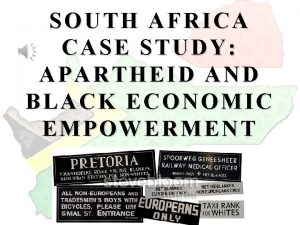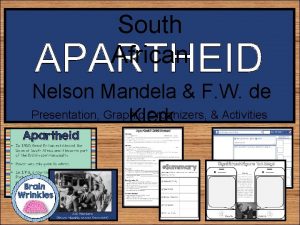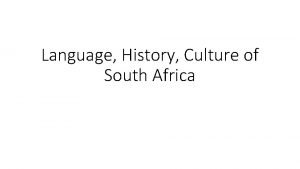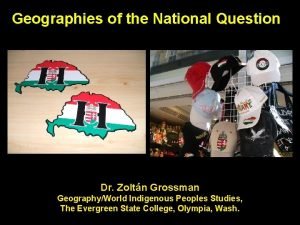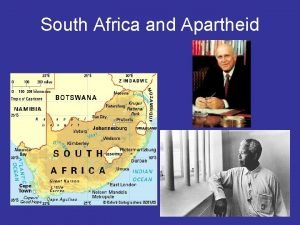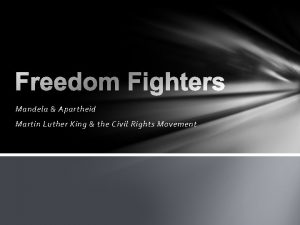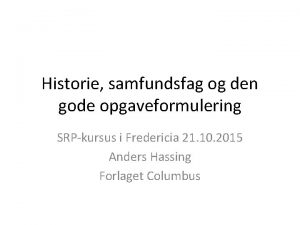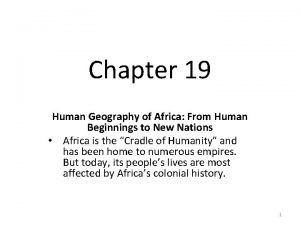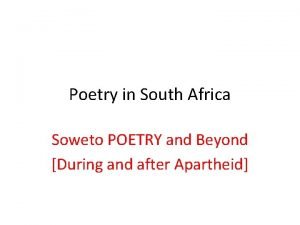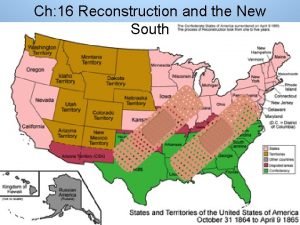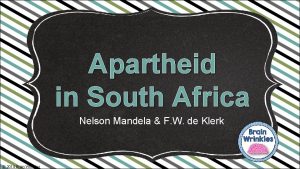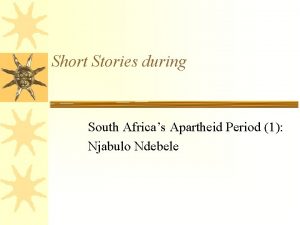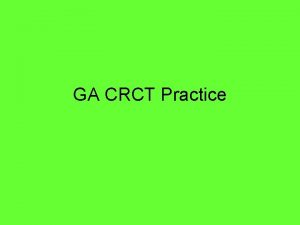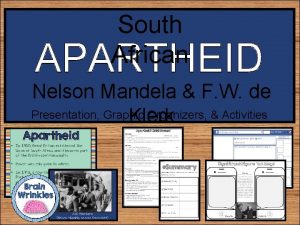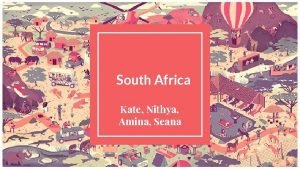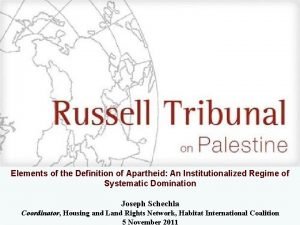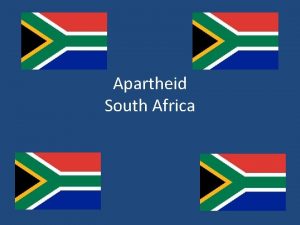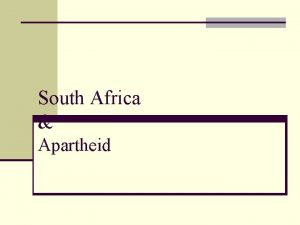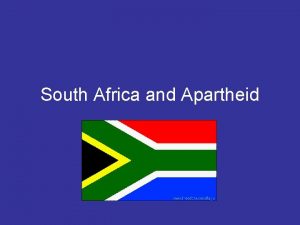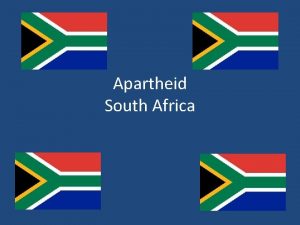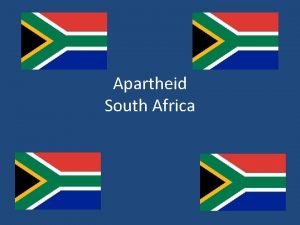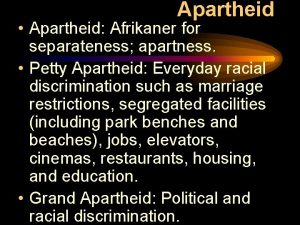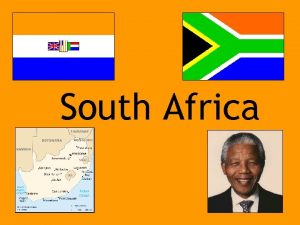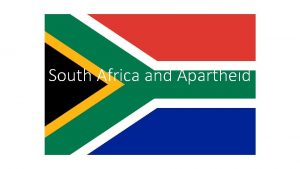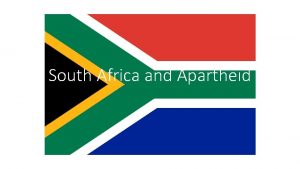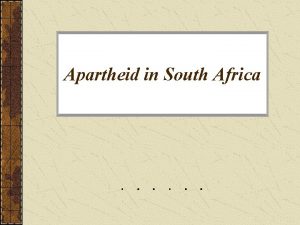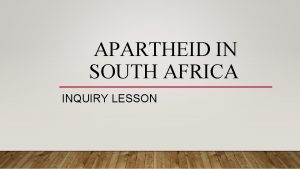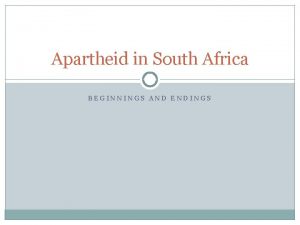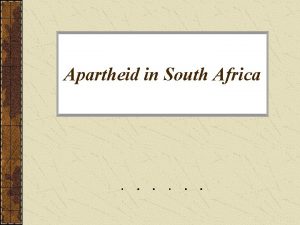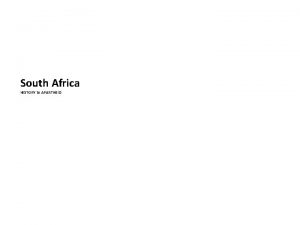SOUTH AFRICA Opposition to Apartheid ANC Opposition ANC



















- Slides: 19

SOUTH AFRICA Opposition to Apartheid

ANC Opposition ANC – set up in 1912 for social and political changes for black Africans. Leaders like Nelson Mandela, Albert Luthuli, Walter Sisulu etc took the campaign forward and organised it. Aims were to fight against white domination and to get black rights in terms of politics. They used primarily peaceful methods e. g. boycotts, demonstrations etc Youth League – young members of the ANC set this up. They did not want to work with different races or non – Christians e. g. Indians or Communists. This was because they felt their problems were different. 1947 – Mandela and Tambo take control of the Youth League. They set out a programme of; Rejection of racial segregation Taking non-violent action against Apartheid To work independently of the whites Eventually Mandela joined with INC because he was impressed with the work of Ghandi. Nelson Mandela and others were now leaders of the ANC. Defiance Campaign – planned by ANC to oppose Apartheid. Happened on April 1952, during whites celebrating 300 years since Boers came to SA. Black Africans across SA refused to obey Apartheid laws. By October – 2, 000 people were arrested

ANC Opposition (2) Freedom Charter Congress – ANC wanted to hold a nationwide meeting to bring together blacks, Indians, coloured people and some whites, in order to adopt the Freedom Charter. The Freedom Charter demanded equal rights and political rights for black people. Most of the leaders had been banned, but 3, 000 still attended. Government arrested 150+ people. Treason Trials – followed the Freedom Charter Congress. Defendants charged with treason and communism. Due to the trial being badly organised it carried on for years. Accused were eventually acquitted of all charges. However, it lead to some of SA’s most important political figures being out of politics for 5 years.

Other Protest Movements Forms of protest also came from Women; Anti – pass laws demonstrations – 1952, government decided to extend Pass Laws to women. 1956 a group of women from all races asked to meet the government minister responsible for this. Due to his refusal, a massive all-women demonstration occupied government offices in Pretoria. The Black Sash – organisation of white, mainly middle class women who worked with black women to appose Apartheid. 1956 the federation of SA Women marched in Pretoria in relation to the Pass Laws. Their president was Lillian Ngoyi who worked with Helen Joseph. Beer Hall Protests – black women in cities made money through brewing beer in their homes and selling it. This was banned by the government and they set up their own beer halls. Women’s beer halls were raided and they were fined. 1959 – women were so angry they burnt two official beer halls and the next

Other Protest Movements (2) Bus boycotts – many black Africans had to travel miles to get to their jobs. Government paid bus companies to keep fares down so people wouldn’t ask for higher wages, but some did anyway. This caused unrest and hardship. In 1957, in the township of Alexandra black people boycotted the buses and took other means instead. Police harassed them but it eventually worked and fares were reduced. Rural Protest – government ordered cattle – killing policy to avoid over grazing and to improve quality of soil in Bantustans. This caused widespread trouble e. g. the protest in Pondoland took years to end. Chiefs of Bantustans were put in a difficult position, they were expected to follow white rules, but black people were very angry. Chiefs who refused to follow the policy were removed and replaced by ‘puppets’ White people – United Party became official opposition group in 1948. It rejected Apartheid but did believe in segregation and white supremacy. Progressive Party – started in 1959 by people who left the United Party they believed in protecting human and political rights for all South Africans. Congress Party – wanted white supremacy, but most of its members were communists so they were banned. Other groups – Inkatha was set up by Chief Buthelezi a prime minister of a Bantustan in 1975. They wanted Zulus to be independent from SA and rejected the ANC’s ideas of a united SA. Many of its supported were massacred. United Democratic Front – formed in 1983, 565 groups from all different backgrounds united against Apartheid.

Anti – Apartheid Protest Leaders Chief Buthelezi – left ANC to get white government to let him be the Chief of the Zulu Bantustan. He was appointed Chief of Kwa. Zulu and granted him a very large salary. He strengthened Inkatha, which was a movement founded in 1922. Claimed there were millions of followers, but there were no records to support this. Thought all Zulus were part of Inkatha because of their ethnicity but some were even members of the ANC. Zulu’s had the largest percentage in SA, 30% of all blacks were Zulu and therefore has a lot of power. During the 70 s and 80 s he was the most important person in SA because the ANC was banned and there was no black protest. Many blacks hated him due to his relationship with the white people. E. g. funeral in 1978. End of his influence happened in 1990 when the ANC was unbanned and there was a new, democratic SA. Racial groups had no importance anymore, so the power of the Zulus was gone.

Anti- Apartheid Protest Leaders (2) Nelson Mandela – after Sharpeville massacre, ANC set up MK to carry out armed struggle against Apartheid. They didn’t want all out war against whites, because they didn’t want to kill and instead attacked unmanned things like Pylons for electricity. Despite this some MK members did go around killing whites and Nelson Mandela went into hiding. Travelled around all of SA organising the MK and used disguises to avoid the police. He went to Britain to speak with British political leaders but was stopped and jailed for 5 years by the Bureau of State Security. Despite this the MK continued their sabotage; 200 by 1963. Police found MK bas in Rivonia and Mandela and others were arrested and charged with treason. Which meant the death penalty. 1964 – eight defendants sentenced to life imprisonment on Robben Island. Mandela stayed there for 18 years before moving to a jail on the mainland was kept in isolation for the first 18 months. The did hard labour, were chained together and driven by guards. Despite this in Prison he worked hard; Woke up at 3: 30 everyday to exercise Studied law Became the leader of a group in prison who argued for basic human rights. Educated himself and others in politics, literature and history. Was released in 1990 at 72 years old and did so when all his fellow prisoners were released. His terms were that the ANC and all the other protest parties had to be unbanned and that he would not retire. His speech after being released showed that he did not change his beliefs or had been disheartened. Some white people were angered by this but others were surprised and relieved at him not wanting revenge. When released he did not immediately take his place in the ANC but after Tambo became ill he did.

Anti – Apartheid Protest Leaders (3) Oliver Tambo – one of the men who formed the ANC youth league with Sisulu and Mandela and joined them as leaders. Helped organise the Defiance Campaign. He served with a five year banning order after the Treason Trials. Nominated by the NAC to go revive the ANC in other countries due to it being banned in SA. Moved to London and tried to get money, arms and shelter for the ANC. Argued that other countries should have harsh sanctions on SA. Managed to get ANC recognised by the United Nations and Organisation of African Unity. He was largely respected internationally. Returned to SA in 1991, after a stroke. Walter and Albertina Sisulu – friend of Mandela who helped form the ANC youth league. He was a member before Mandela and Tambo. Came up with the idea of ‘stay at home’ as a part of civil disobedience. He was the general secretary of the ANC. 1953 – he toured China, Romania, Britain and Israel and when he returned he joined the communist party. He was banned for 6 months but he continued his ANC work in secret and helped organise the Freedom Charter Congress. He was one of the people in the Treason Trials but eventually was acquitted.

Anti – Apartheid Protest Leaders (4) Steve Biko – was part of the black consciousness movement after emerging from his medicine degree as one of the brightest and most intelligent thinkers. Studied writings of MLK and MX. Set up student union for blacks only. Travelled all over SA, speaking out. Set up Black Consciousness Conference. Set up a health centre. Gave jobs to people working in his organisation making leather, Soweto students were inspired by his ideas even though he had never met them. Authorities viewed him as a very bad influence. As a result he was arrested and kept naked for 18 days chained to a wall and then he was beaten and put into the back of a Range Rover, he was then taken to a hospital where he died at 30. 45 th person to die in police custody due to the introduction of detention without trial. Robert Sobukwe – one of the young blacks who were disappointed by the ANC’s lack of action and didn’t like the effort they made with other races. 1959 – he left the ANC and set up the PAC which was solely an African movement. They did things like the Pass Laws demonstrations and the Sharpeville incidents. They wanted a more extreme form of protest instead of what the ANC were doing. The Sharpeville demonstration led to 69 killed. Imprisoned from 1961 - 1964 but was then rearrested because he was seen as a threat. Eventually released in 1969, but was banned and did law until he died.

Anti – Apartheid Protest Leaders (5) Chris Hani – joined MK in 1962 and with his high level of education he rose quickly and was in a position of leadership. 1962 – arrested for suppression of communism act. 1963 – went into exile. 1973 – organised units of the MK for guerrilla operations in SA. 1982 – several attempts at assassination. 1983 – he was one of the leaders who joined the student recruits with the ANC in exile. 1987 – continued to rise and became the Chief of Staff of the MK. With the unbanning of the ANC, he returned too SA and became a popular speaker in townships. 1990 – was known to have a close friendship with a member of the communist party. 1992 – stepped down from his position in the MK and campaigned for the SACP in townships in order to redefine its place as a national political party. It was soon doing better than the ANC and was especially popular with young people who had no experience pre-Apartheid and no commitment to the democratic ideas of Mandela. Was described as charismatic etc and soon had a cult following. 1993 – returned home to SA and was assassinated by a polish anti – communist.

Role of the Church Government suppression of the anti-apartheid groups limited their influence but the same didn’t happen for church activism. This meant that the government were far less likely to arrest or attack religious leaders which allowed them to be more politically active against Apartheid. They did take some action against churches. Beyers Naude – left Dutch Reformed Church and became the general secretary of the SACC a religious association which supported anti-apartheid activities. It also refused violence as a means of ending Apartheid. Frank Chikane – another general secretary of SACC. Was detained for times and due his criticism of the government who wanted to kill him. Archbishop Desmond Tutu – another general secretary of the SACC. Awarded the Nobel Peace Prize in 1984. Used his position and popularity to bring down the government and it’s policies. 1988 – Tutu and other church leaders were arrested for protesting outside Parliamentary buildings in Cape Town. Alan Boesak – led the WARC and was very influential in finding the UDF. Was once jailed for organising a march demanding the release of Mandela. Trevor Huddleston – white, British bishop who fought against Apartheid and was a Christian missionary in Sophia town. Over 13 years in Sophia town he became a much loved priest and anti-apartheid activist which earned him the name ‘makhalipile’. 1955 – ANC gave him the rare honour of the Isitwalandwe. 1956 - Returned to England to continue his church work. Worked as an anti – apartheid campaigner after retiring from church work.

Role of Women Lillian Nyogi – joined ANC women’s league in 1952 and a year later was elected as the President. 1956 – she led a march with Helen Joseph etc against the Apartheid government extending the pass laws to women. She travelled illegally to Switzerland to take part in a conference and she travelled to other countries often under a fake name. She visited England, Germany, China, Russia etc meeting other women leaders who were mainly left wing and then returned to SA. When she returned she was very popular, she was a great speaker and inspired many. 1956 – she was arrested and spent 71 days in confinement and then was banned for 11 years which were very severe and hardly let her leave her home. Helen Joseph – born in England became an anti-apartheid campaigner after moving to SA in 1931. Helped set up the Federation of South African Women and worked as Lillian's secretary. She helped readout the freedom charter during the congress. She helped set up the Pass Law Protest. 1956 – she was tried at the treason trials and charged with high treason. 1957 – she was banned. 1962 – became first person to be placed under house arrest due to the sabotage act. She had escaped death many times due to the attempts made on her. She wad lifted of her ban when she was 80 years old. 1959 – progressive party formed to stand against Apartheid and Helen was the only member to keep her seat in parliament and even though she was alone she spoke openly about her beliefs. Winnie Mandela – was already active in politics before she married Mandela. Once Nelson was imprisoned government focused on her and had banning orders on her and was placed under house arrest. She was forced to move from her home in Soweto a remote home just outside her husbands prison. ANC and Winnie helped keep Nelson Mandela’s reputation alive in the media and when Apartheid started to go wrong the ‘free nelson Mandela’ she helped too.

Sharpeville 1960 Causes; PAC was set up in 1959 and wanted more drastic action. PAC organised nationwide protest against Pass Laws. 21, 00 people lived in Sharpeville. Unemployment was very high. Rent hard risen sharply and those who could not afford it were sent to Bantustans. 5, 000 gathered on the 21 st of March 1960 and it grew to 20, 000. Events; Fence surrounding a police station broke and a police man was injured in the process. Police open fire with stun guns. 69 Africans killed and most have been shot in the back whilst running away with bullets. 186 wounded.

Sharpeville 1960 Consequences; Day of morning by Albert Luthuli happened the next day. Many Africans stayed off work in protest. Guns shops sold out as white people armed themselves. Commission of Enquiry was made and it found out that there was no warning shot and that the police officers were too young and inexperienced to know that there was a ceasefire. ANC and PAC declared illegal. 18, 000 people imprisoned. State of emergency declared. Sobukwe imprisoned for 9 years. Protest marches in Durban and Cape town demanded the release of leaders. Banning, curfews and arrests were made. ANC set up MK and the sabotage campaign. PAC set up Poqo The Rivonia Trial – Mandela and others arrested in suspect of sabotage. MK were discovered and broken up. They did show trial at Rivonia to help destroy the ANC’s reputation. The defendants feared execution but in the end they were sentenced to life imprisonment. Mandela makes beautiful speech. Show trials used every year after this until 1987

Soweto 1976 Causes; 1976 government orders that half the school curriculum should be delivered in Afrikaans which was very difficult learn. Youth unemployment was very high. Government wanted to make Bantustans independent. Prevention of black people working in white areas. Black Africans would lose their SA citizenship. SASO planned a protest march. Events; March took place on 16 June 1976 Senior pupil spoke to the crowd and asked for calm. Police surround gathering. Teargas thrown into the crowd. One shot led to many more 2 killed and 12 inured. News spread among black people. Barricades built 100 of police arrive and Soweto erupts into violence. Arrests are made, many are children. Number of dead was 176.

Soweto 1976 Consequences; Commission of Enquiry made showed that 575 died in the aftermath. 104 children under 17 were arrested. Government banned all organisation associated with black consciousness e. g. SASO. Boycotts in Soweto and burning of buildings. 1980 unrest caused black people to join trade unions. Thousands of young Africans left SA to join the ANC in exile. Support for ANC grew in townships and its flags were draped on the coffins of the dead. During the 25 th anniversary of the Sharpeville incidents, 20 Africans were shot dead at a funeral. Protest spread and there was a bombing campaign in Port Elizabeth and Durban.

International Pressure Against Apartheid Commonwealth – 1960 SA held a vote on whether to leave the commonwealth and they left in May 1961. Relations between the UK and SA were strained since the 1950 s. Commonwealth was dominated by newly independent African states who apposed apartheid. 1960 – British prime minister visited SA and made his ‘wind of change’ speech against Apartheid. United Nations – 1948 the resolution was passed that all races were equal and Apartheid opposed this. 1945 – UN debated Apartheid and SA control of Namibia. Sharpeville shooting brought criticism from the UN and as more new independent African states joined the UN more criticism was had. Namibia – SWA belonged to Germany and from 1919 SA looked after it to prepare for independence. SA took resources from the country and imposed Apartheid instead. UN insisted that SWA should be given up by SA but they refused and instead took steps to bring SWA completely under their control. 1960 – guerrilla style group set up to oppose this called the SWAPO. 1971 – UN made SA control over SWA illegal and recognised SWAPO as the official government but still SA ignored the UN. 30 years of brutal fighting followed. 1989 – Namibia allowed to hold elections. 1990 – Namibia became independent. OAU – PAC and ANC had been banned so they had to set up abroad, together with other protest groups they set up OAU. They aimed to put pressure on the UN to fore the end of Apartheid. SA government however were clever and began trade agreements with newly formed African independent states so they would not oppose them. It also meant that they were nor allowed to issue ‘economic sanctions’ on SA

International Pressure Against Apartheid (2) Economic Sanctions – 1962 the UN imposed this on SA, members were also told to end diplomatic relations and ports and airports were closed to SA planes and boats. 1963 – UN banned sales of arms to SA and the OPEC banned oil sales to SA. After Soweto the US Sullivan Code pressured the US firms to withdraw from SA. 1986 – US banned new investments and loans in SA and the import of uranium, coal, iron and steel. Huge companies like Coca Cola closed down their companies in SA. The European Economic Community also imposed economic sanctions. 1989 – all commonwealth countries except the UK wanted a three tier plan; 1 st – end all agricultural and manufactures imports from SA 2 nd – ban oils and arms from SA 3 rd – ban gold exports from SA Western banks stopped loans to SA These sanctions weren't always applied.

International Pressure Against Apartheid (3) Sporting boycotts – 1969 a coloured cricketer was selected to be a part of the English team touring SA but the SA government would not let him play against white SA team. Tour was cancelled and a move was started to ban SA from sport home and away. 1968 – African countries threatened to boycott the Mexican Olympics due to SA presence. 1970 – SA banned from the Olympic Movement. 1976 – any country playing with SA also banned. 1977 – commonwealth cut off all sporting links and UN passed the international declaration against Apartheid in sport. These measures weren't always successful. Ordinary people – AAM emerged in 1950 s and by 1970 s branches had been set up in Europe. AAM was strong in Nordic countries which used the UN against Apartheid. They organised boycotts and sanctions and gave military aid to anti apartheid movements and helped refugees.
 What is apartheid
What is apartheid Apartheid south africa
Apartheid south africa Apartheid in south africa cloze notes 1
Apartheid in south africa cloze notes 1 Apartheid
Apartheid Apartheid
Apartheid What is apartheid
What is apartheid Apartheid definition
Apartheid definition Martin luther king apartheid
Martin luther king apartheid Anders hassing
Anders hassing The mutapa empire thrived on the trade of diamonds.
The mutapa empire thrived on the trade of diamonds. What was apartheid
What was apartheid No baby must weep poem
No baby must weep poem Apartheid vs jim crow venn diagram
Apartheid vs jim crow venn diagram Apartheid
Apartheid The prophetess by njabulo ndebele analysis
The prophetess by njabulo ndebele analysis Which phrase best describes the focus of ecology? *
Which phrase best describes the focus of ecology? * Apartheid comprehension check answer key
Apartheid comprehension check answer key Kapske gore
Kapske gore Apartheid
Apartheid Definition
Definition
